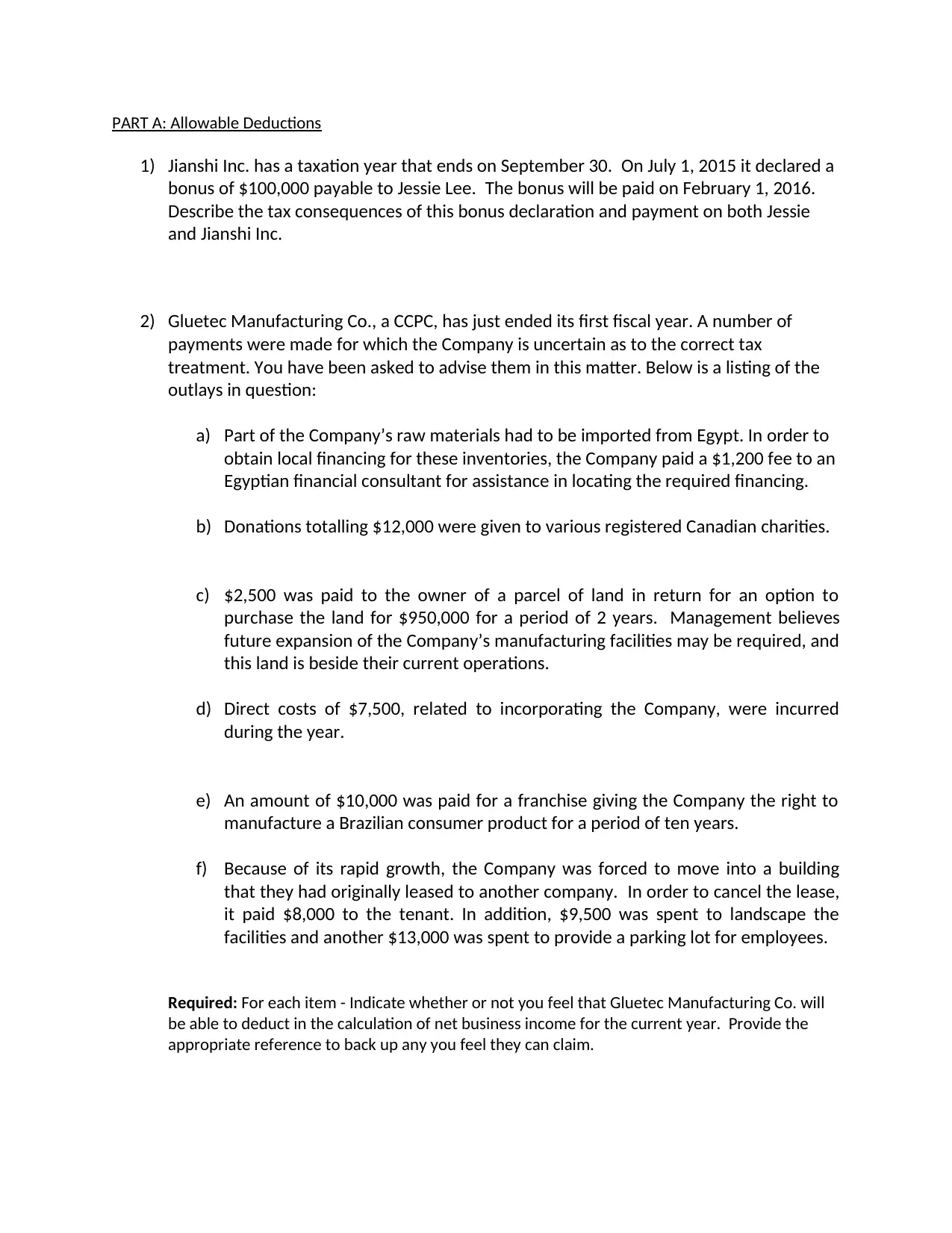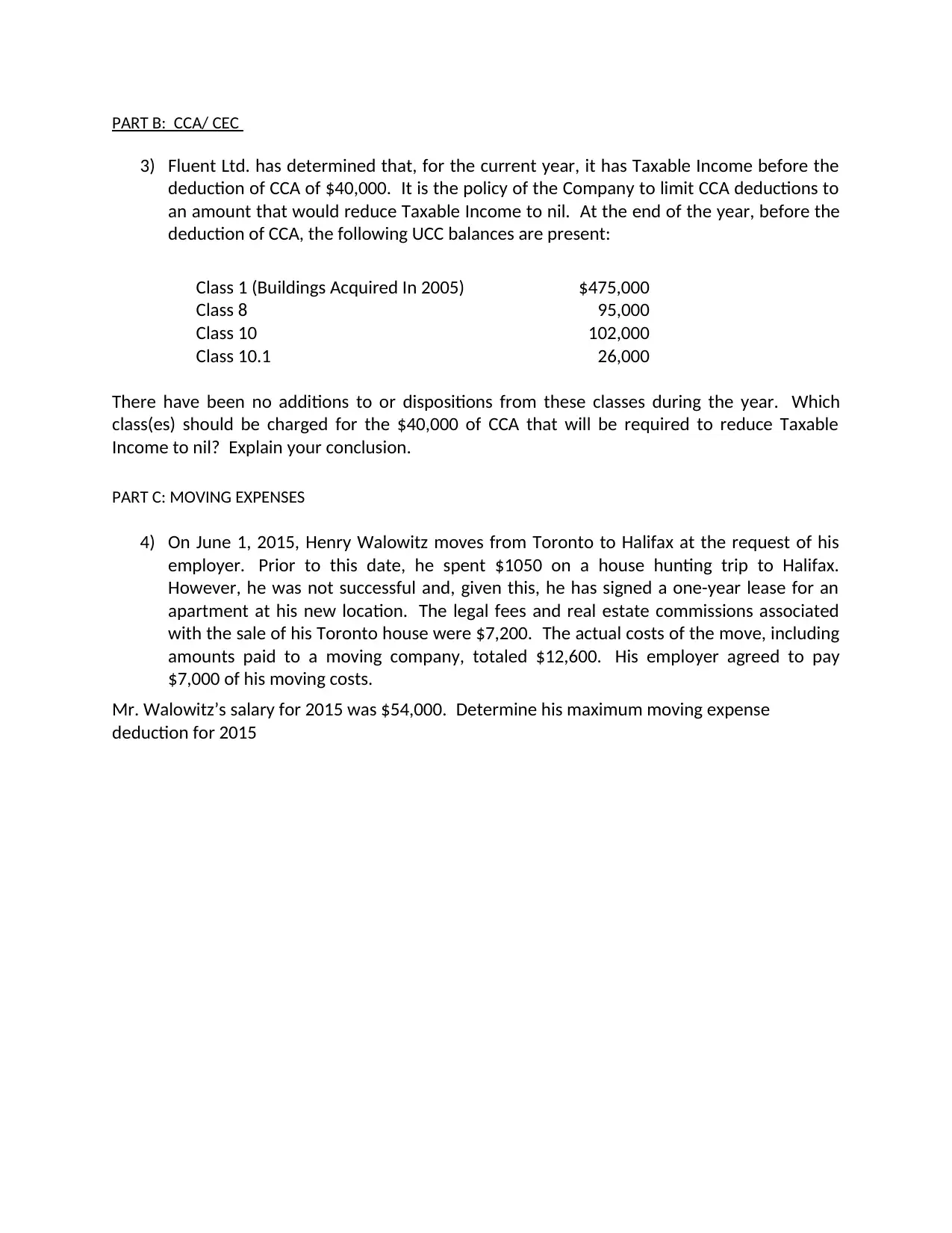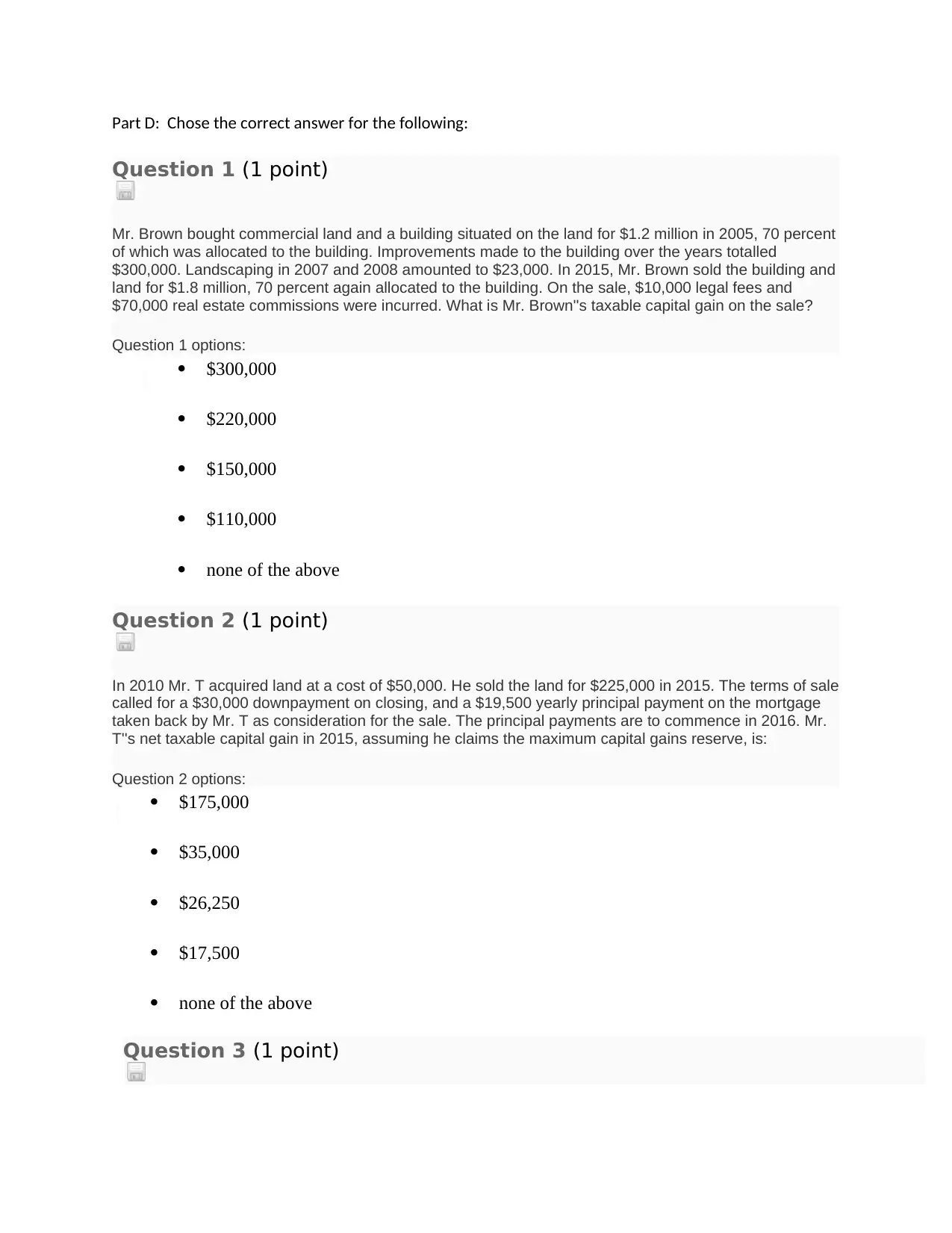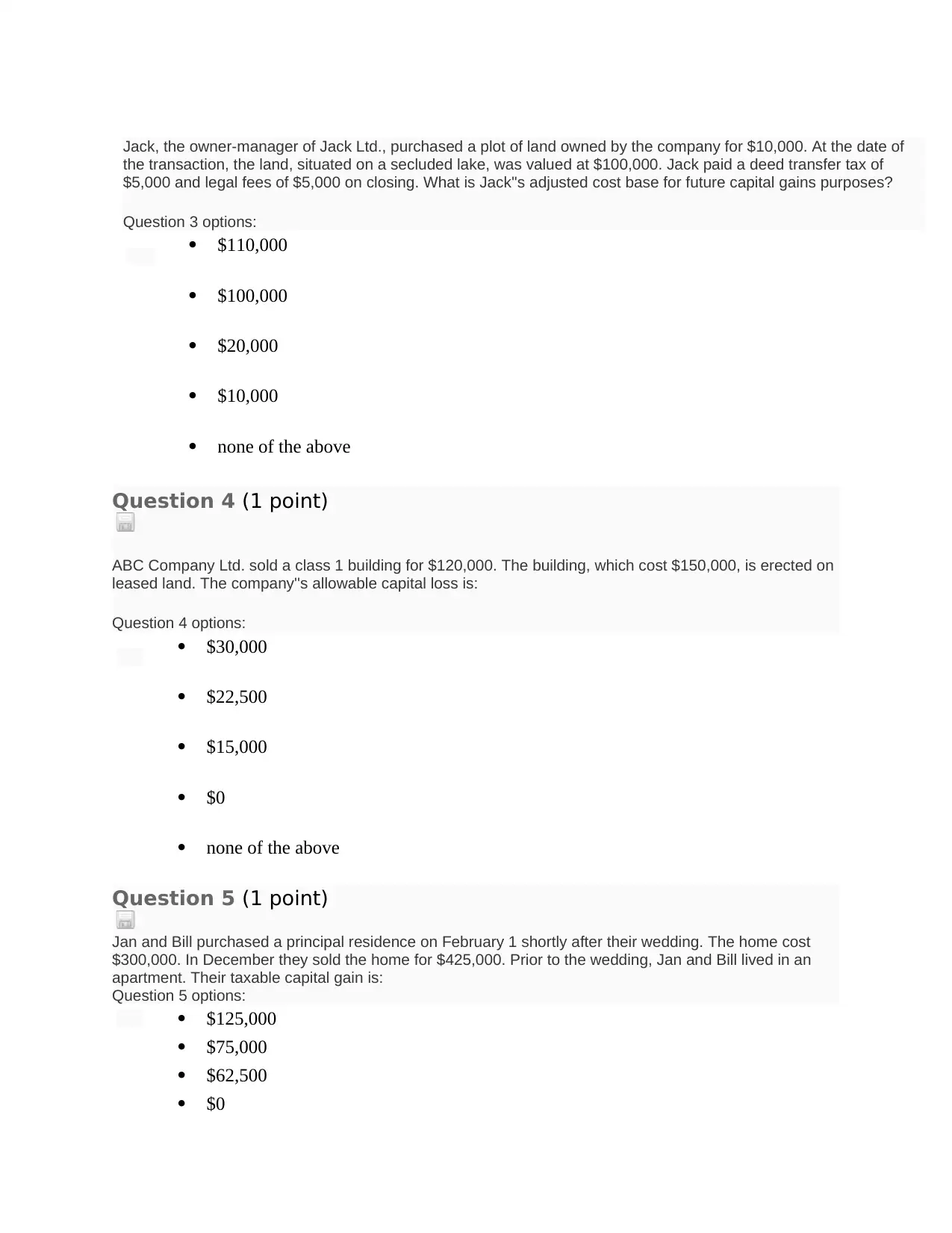Tax Consequences and Allowable Deductions
VerifiedAdded on 2019/09/20
|5
|1128
|397
Case Study
AI Summary
The assignment content consists of four parts: PART A - Allowable Deductions for Jianshi Inc. and Gluetec Manufacturing Co., discussing various outlays that may be deductible or not; PART B - CCA/CEC, where Fluent Ltd. has to determine the class(es) to charge for its CCA deductions; PART C - Moving Expenses, which involves Henry Walowitz's relocation from Toronto to Halifax and his employer's contribution towards his moving costs; and PART D - Chose the correct answer for five questions on various taxation topics, including capital gains and losses.
Contribute Materials
Your contribution can guide someone’s learning journey. Share your
documents today.

PART A: Allowable Deductions
1) Jianshi Inc. has a taxation year that ends on September 30. On July 1, 2015 it declared a
bonus of $100,000 payable to Jessie Lee. The bonus will be paid on February 1, 2016.
Describe the tax consequences of this bonus declaration and payment on both Jessie
and Jianshi Inc.
2) Gluetec Manufacturing Co., a CCPC, has just ended its first fiscal year. A number of
payments were made for which the Company is uncertain as to the correct tax
treatment. You have been asked to advise them in this matter. Below is a listing of the
outlays in question:
a) Part of the Company’s raw materials had to be imported from Egypt. In order to
obtain local financing for these inventories, the Company paid a $1,200 fee to an
Egyptian financial consultant for assistance in locating the required financing.
b) Donations totalling $12,000 were given to various registered Canadian charities.
c) $2,500 was paid to the owner of a parcel of land in return for an option to
purchase the land for $950,000 for a period of 2 years. Management believes
future expansion of the Company’s manufacturing facilities may be required, and
this land is beside their current operations.
d) Direct costs of $7,500, related to incorporating the Company, were incurred
during the year.
e) An amount of $10,000 was paid for a franchise giving the Company the right to
manufacture a Brazilian consumer product for a period of ten years.
f) Because of its rapid growth, the Company was forced to move into a building
that they had originally leased to another company. In order to cancel the lease,
it paid $8,000 to the tenant. In addition, $9,500 was spent to landscape the
facilities and another $13,000 was spent to provide a parking lot for employees.
Required: For each item - Indicate whether or not you feel that Gluetec Manufacturing Co. will
be able to deduct in the calculation of net business income for the current year. Provide the
appropriate reference to back up any you feel they can claim.
1) Jianshi Inc. has a taxation year that ends on September 30. On July 1, 2015 it declared a
bonus of $100,000 payable to Jessie Lee. The bonus will be paid on February 1, 2016.
Describe the tax consequences of this bonus declaration and payment on both Jessie
and Jianshi Inc.
2) Gluetec Manufacturing Co., a CCPC, has just ended its first fiscal year. A number of
payments were made for which the Company is uncertain as to the correct tax
treatment. You have been asked to advise them in this matter. Below is a listing of the
outlays in question:
a) Part of the Company’s raw materials had to be imported from Egypt. In order to
obtain local financing for these inventories, the Company paid a $1,200 fee to an
Egyptian financial consultant for assistance in locating the required financing.
b) Donations totalling $12,000 were given to various registered Canadian charities.
c) $2,500 was paid to the owner of a parcel of land in return for an option to
purchase the land for $950,000 for a period of 2 years. Management believes
future expansion of the Company’s manufacturing facilities may be required, and
this land is beside their current operations.
d) Direct costs of $7,500, related to incorporating the Company, were incurred
during the year.
e) An amount of $10,000 was paid for a franchise giving the Company the right to
manufacture a Brazilian consumer product for a period of ten years.
f) Because of its rapid growth, the Company was forced to move into a building
that they had originally leased to another company. In order to cancel the lease,
it paid $8,000 to the tenant. In addition, $9,500 was spent to landscape the
facilities and another $13,000 was spent to provide a parking lot for employees.
Required: For each item - Indicate whether or not you feel that Gluetec Manufacturing Co. will
be able to deduct in the calculation of net business income for the current year. Provide the
appropriate reference to back up any you feel they can claim.
Secure Best Marks with AI Grader
Need help grading? Try our AI Grader for instant feedback on your assignments.

PART B: CCA/ CEC
3) Fluent Ltd. has determined that, for the current year, it has Taxable Income before the
deduction of CCA of $40,000. It is the policy of the Company to limit CCA deductions to
an amount that would reduce Taxable Income to nil. At the end of the year, before the
deduction of CCA, the following UCC balances are present:
Class 1 (Buildings Acquired In 2005) $475,000
Class 8 95,000
Class 10 102,000
Class 10.1 26,000
There have been no additions to or dispositions from these classes during the year. Which
class(es) should be charged for the $40,000 of CCA that will be required to reduce Taxable
Income to nil? Explain your conclusion.
PART C: MOVING EXPENSES
4) On June 1, 2015, Henry Walowitz moves from Toronto to Halifax at the request of his
employer. Prior to this date, he spent $1050 on a house hunting trip to Halifax.
However, he was not successful and, given this, he has signed a one-year lease for an
apartment at his new location. The legal fees and real estate commissions associated
with the sale of his Toronto house were $7,200. The actual costs of the move, including
amounts paid to a moving company, totaled $12,600. His employer agreed to pay
$7,000 of his moving costs.
Mr. Walowitz’s salary for 2015 was $54,000. Determine his maximum moving expense
deduction for 2015
3) Fluent Ltd. has determined that, for the current year, it has Taxable Income before the
deduction of CCA of $40,000. It is the policy of the Company to limit CCA deductions to
an amount that would reduce Taxable Income to nil. At the end of the year, before the
deduction of CCA, the following UCC balances are present:
Class 1 (Buildings Acquired In 2005) $475,000
Class 8 95,000
Class 10 102,000
Class 10.1 26,000
There have been no additions to or dispositions from these classes during the year. Which
class(es) should be charged for the $40,000 of CCA that will be required to reduce Taxable
Income to nil? Explain your conclusion.
PART C: MOVING EXPENSES
4) On June 1, 2015, Henry Walowitz moves from Toronto to Halifax at the request of his
employer. Prior to this date, he spent $1050 on a house hunting trip to Halifax.
However, he was not successful and, given this, he has signed a one-year lease for an
apartment at his new location. The legal fees and real estate commissions associated
with the sale of his Toronto house were $7,200. The actual costs of the move, including
amounts paid to a moving company, totaled $12,600. His employer agreed to pay
$7,000 of his moving costs.
Mr. Walowitz’s salary for 2015 was $54,000. Determine his maximum moving expense
deduction for 2015

Part D: Chose the correct answer for the following:
Question 1 (1 point)
Mr. Brown bought commercial land and a building situated on the land for $1.2 million in 2005, 70 percent
of which was allocated to the building. Improvements made to the building over the years totalled
$300,000. Landscaping in 2007 and 2008 amounted to $23,000. In 2015, Mr. Brown sold the building and
land for $1.8 million, 70 percent again allocated to the building. On the sale, $10,000 legal fees and
$70,000 real estate commissions were incurred. What is Mr. Brown''s taxable capital gain on the sale?
Question 1 options:
$300,000
$220,000
$150,000
$110,000
none of the above
Question 2 (1 point)
In 2010 Mr. T acquired land at a cost of $50,000. He sold the land for $225,000 in 2015. The terms of sale
called for a $30,000 downpayment on closing, and a $19,500 yearly principal payment on the mortgage
taken back by Mr. T as consideration for the sale. The principal payments are to commence in 2016. Mr.
T''s net taxable capital gain in 2015, assuming he claims the maximum capital gains reserve, is:
Question 2 options:
$175,000
$35,000
$26,250
$17,500
none of the above
Question 3 (1 point)
Question 1 (1 point)
Mr. Brown bought commercial land and a building situated on the land for $1.2 million in 2005, 70 percent
of which was allocated to the building. Improvements made to the building over the years totalled
$300,000. Landscaping in 2007 and 2008 amounted to $23,000. In 2015, Mr. Brown sold the building and
land for $1.8 million, 70 percent again allocated to the building. On the sale, $10,000 legal fees and
$70,000 real estate commissions were incurred. What is Mr. Brown''s taxable capital gain on the sale?
Question 1 options:
$300,000
$220,000
$150,000
$110,000
none of the above
Question 2 (1 point)
In 2010 Mr. T acquired land at a cost of $50,000. He sold the land for $225,000 in 2015. The terms of sale
called for a $30,000 downpayment on closing, and a $19,500 yearly principal payment on the mortgage
taken back by Mr. T as consideration for the sale. The principal payments are to commence in 2016. Mr.
T''s net taxable capital gain in 2015, assuming he claims the maximum capital gains reserve, is:
Question 2 options:
$175,000
$35,000
$26,250
$17,500
none of the above
Question 3 (1 point)

Jack, the owner-manager of Jack Ltd., purchased a plot of land owned by the company for $10,000. At the date of
the transaction, the land, situated on a secluded lake, was valued at $100,000. Jack paid a deed transfer tax of
$5,000 and legal fees of $5,000 on closing. What is Jack''s adjusted cost base for future capital gains purposes?
Question 3 options:
$110,000
$100,000
$20,000
$10,000
none of the above
Question 4 (1 point)
ABC Company Ltd. sold a class 1 building for $120,000. The building, which cost $150,000, is erected on
leased land. The company''s allowable capital loss is:
Question 4 options:
$30,000
$22,500
$15,000
$0
none of the above
Question 5 (1 point)
Jan and Bill purchased a principal residence on February 1 shortly after their wedding. The home cost
$300,000. In December they sold the home for $425,000. Prior to the wedding, Jan and Bill lived in an
apartment. Their taxable capital gain is:
Question 5 options:
$125,000
$75,000
$62,500
$0
the transaction, the land, situated on a secluded lake, was valued at $100,000. Jack paid a deed transfer tax of
$5,000 and legal fees of $5,000 on closing. What is Jack''s adjusted cost base for future capital gains purposes?
Question 3 options:
$110,000
$100,000
$20,000
$10,000
none of the above
Question 4 (1 point)
ABC Company Ltd. sold a class 1 building for $120,000. The building, which cost $150,000, is erected on
leased land. The company''s allowable capital loss is:
Question 4 options:
$30,000
$22,500
$15,000
$0
none of the above
Question 5 (1 point)
Jan and Bill purchased a principal residence on February 1 shortly after their wedding. The home cost
$300,000. In December they sold the home for $425,000. Prior to the wedding, Jan and Bill lived in an
apartment. Their taxable capital gain is:
Question 5 options:
$125,000
$75,000
$62,500
$0
Secure Best Marks with AI Grader
Need help grading? Try our AI Grader for instant feedback on your assignments.

none of the above
1 out of 5
Your All-in-One AI-Powered Toolkit for Academic Success.
+13062052269
info@desklib.com
Available 24*7 on WhatsApp / Email
![[object Object]](/_next/static/media/star-bottom.7253800d.svg)
Unlock your academic potential
© 2024 | Zucol Services PVT LTD | All rights reserved.